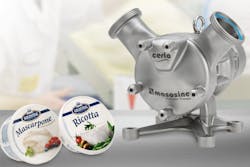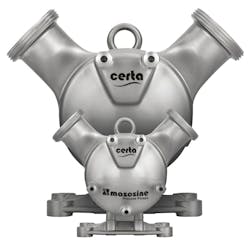German cheese producer GOLDSTEIG Bavarian Forest Cheese Factory recently began using new sine pump technology for manufacturing Italian cream cheese specialties. Certified to European Hygienic Engineering and Design Group (EHEDG) EL Aseptic Class I standards, the pump was specifically developed for use in the food and beverage industry. At GOLDSTEIG it is being used to pump sensitive cream for mascarpone and ricotta cheese. Company spokespeople are impressed by its gentle pumping and ease of cleaning, as well as its low maintenance and energy consumption.
Gentle transportation for product quality
GOLDSTEIG operates one of the most modern cheese factories in Europe. The company operates three plants that employ 620 staff who produce more than 220,000 pounds of cheese per year from 223.6 million gallons of milk.
The plant in the Lower Bavarian town of Tittling near Passau focuses on producing Italian cream cheese specialties like ricotta and mascarpone as well as butter. Operations Manager Günter Schlattl explains that mascarpone is produced using cream, while whey is the main ingredient needed to make ricotta. Both are delivered to Tittling from another plant.
The plant uses a microparticulation process, in which ground particles are exposed to heat and placed in a vacuum until the particles separate further. The modern procedure maximizes product yield during manufacture without producing any waste product.
Various ingredients are added to the cream and whey in a tank with a capacity of about 8,000 gallons. This mixture must then be pumped to the microparticulation system, whereby coagulation and actual production of the cream cheese takes place. The process uses a surface heat exchanger at different temperatures and pressures.
The system must pump approximately 528 gallons per hour. “The transportation is an important stage of production, where due care and the gentlest possible pumping matter most,” said Schlattl. “If the shearing forces are too high, then the binding — and thus the structure of the mixture — can be damaged. Ultimately, the final quality of the cream cheese would suffer. For ricotta and for mascarpone, the texture of the end product is essential.”
Since November 2015 the plant has used a new sine pump for this delicate task. The model used at GOLDSTEIG is a new pump design based on the proven sinusoidal displacement principle. The model has been specially designed for use in the food and beverage industry. Hence, it conveys the product more gently than other types of pumps, including rotary lobe pumps and other sine pump models.
“We had already been using MasoSine sine pumps for several years in our butter production, so we were aware of how gently this type of pump operates, Schlattl confirmed. “And in this respect, the new Certa absolutely delivers what it promises. Its low-shearing force means that the delicate cream is not damaged. The pumps have been running now for well over six months without any problems.”
Florian Walter, product manager at MasoSine Process Pumps, explained that the gentle pumping is one of the pump’s key design features. “With sine pumps, the rotation of sinusoidal rotors creates four equal circumferential chambers. The seal from the pressure side to the suction side is guaranteed by a gate located on the rotor. Because the chambers are displaced as a whole, the medium is very gently conveyed from the inlet port to the outlet.”
Other less efficient lobe pumps, including twin-screw pumps, exhibit high internal slip due to bigger internal clearances and therefore offer less gentle handling. Importantly, different applications — resulting in changes to viscosity, temperature and flow rate — can be easily deployed with one pump setup. This means modifications such as bigger clearances for high-temperature applications are unnecessary.
According to Walter, the pump is up to 50 percent gentler than these other options, making it especially well-suited for shear-sensitive pumped fluids or media that contain large or sensitive particles. This makes it ideal for many different applications in the dairy industry.
“Due to its gentle, virtually pulsation-free operation, the consistency of the results — for example, with yogurt — does not change. Even large pieces of fruit can be processed gently. In the manufacture of cheese, gentle pumping of the cheese curd leads to considerably fewer cheese fines and therefore to a higher yield,” said Walter.
Comprehensive certification
The primary objective in the pump’s development was to fulfill even the most demanding hygiene and clean-in-place (CIP) requirements. For this reason, the number of components in contact with the product was kept to a minimum to ensure ease of cleaning. As a result, it is also easily sterilization-in-place (SIP) capable. The pump significantly minimizes cleaning time, which results in a more efficient production procedure. This quick procedure also means that chemical and water use is reduced, and less wastewater requires disposal.
“Due to its outstanding CIP and SIP capability, not only has the [the pump] been certified to EHEDG EL Class I but it also — as one of only very few pumps on the market — has been certified to EHEDG EL Aseptic Class I,” said Walter. “And of course, it is also 3A certified. Furthermore, all components in contact with the product meet the requirements for food contact as per EC 1935/2004 and the FDA.”
In addition to maximum hygiene and CIP capability, the appropriate certification was another important feature for the Tittling factory applications, since the plant performs a daily CIP clean with caustic. Schlattl reported, “We opened the pump once at the beginning, in order to check the cleaning results. The pump was totally clean.”
Maximum cost efficiency
Meanwhile Schlattl is particularly satisfied with the reliability of the pump. “The new pump has been in use with us for nine months and in all that time has functioned without a single hitch. To date, we have not had to replace any parts, even though it is running a double shift daily for up to twelve hours.”
By nature, sine pumps are design to be superior to other pump types in terms of their need for maintenance. In the new pump, the number of consumables has been reduced compared to previous models. Low power consumption also contributes to the low total cost of ownership. Because of their design, sine pumps consume up to 50 percent less energy than comparable displacement pumps, particularly at higher viscosities. “With current energy prices, we obviously have to bear in mind the energy consumption of our pumps,” said Schlattl.
GOLDSTEIG will likely add more of these pumps. “Should we expand in the future or introduce a new product range, we will definitely rely on another Certa,” concluded Schlattl.
Author’s note: This article was based on an application case study that uses the MasoSine from Watson-Marlow Fluid Technology Group.
Russell Merritt is marketing manager for Watson-Marlow Fluid Technology Group.



